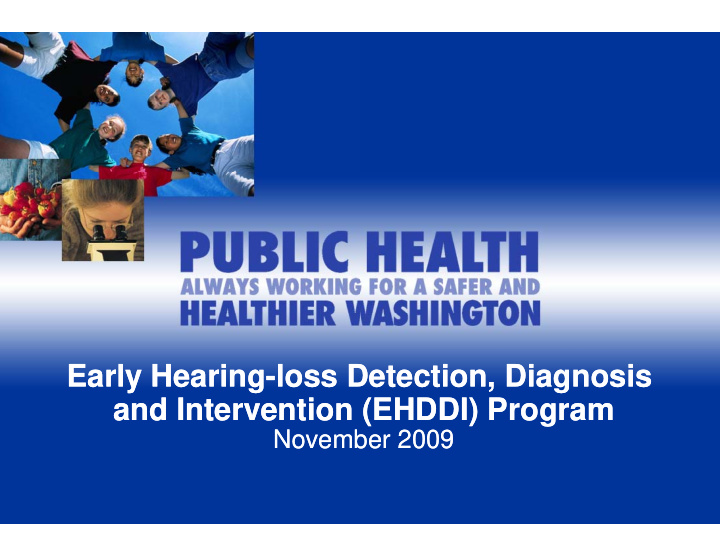



Early Hearing Early Hearing Early Hearing loss D Early Hearing-loss D loss D loss D Detection, Diagnosis Detection, Diagnosis Detection, Diagnosis Detection, Diagnosis and Intervention and Intervention (EHDDI) Program (EHDDI) Program Novemb Novemb ber 2009 ber 2009
Infant Hearing Los Infant Hearing Los ss ss • Up to 270 infants may be born n deaf or with hearing loss in Washington State each year. g y • The first two years of life are c critical for learning speech and language. • Even a mild hearing loss can interfere with a child’s ability to learn speech and language. • Early intervention services by E l i t ti i b 6 6 months of age helps with age th f h l ith appropriate language and soc cial-emotional development. 2 2
Early Detection of Early Detection of Hearing Loss Hearing Loss • 90% of infants with hearing lo ss are born to hearing parents. • Over 50% of infants with hear ring loss have no known risk factor for hearing loss. • Without screening, hearing los Without screening hearing los ss is not typically diagnosed until ss is not typically diagnosed until 12-25 months of age; child ma ay suffer communication or cognitive delays. • The EHDDI program works to o ensure newborns are screened and receive appropriate follow w-up care when needed. 3 3
EHDDI Program G EHDDI Program G oals oals Ensure that all infants bo orn in Washington: • Are screened for hea A d f h aring loss before hospital i l b f h it l discharge or at least by one month of age. • Receive a diagnostic R i di ti c audiological evaluation di l i l l ti by three months of a age. • Are enrolled in early A ll d i l i t intervention (EI) ti (EI) services by six mont ths of age if needed. 4 4
Newborn Hearing Newborn Hearing Screening Screening • Is NOT a test where so omeone: cla aps whispers rings a bell 5
Newborn Hearing Newborn Hearing Screening Screening • Non-invasive • Baby asleep • Automated Test • 10-20 minutes • Result is “pass” or “ref • Result is pass or ref fer” fer • Two types of testing m methods 6 6
Otoacoustic Emiss sions (OAE) ( ) • Probe placed in infants ear. • Tiny microphone sends sounds into the ear. • Inner ear (cochlea) • Inner ear (cochlea) produces an “echo” that is recorded by the microphone in the probe and processed by the machine. 7 7
Auditory Brainstem Auditory Brainstem Response (ABR) Response (ABR) • Auditory stimuli presented to child presented to child • Electrodes measure brain response to brain response to sound. 8 8
Hearing Screening Hearing Screening g Surveillance g Surveillance • 68 birthing hospitals – all have Universal N Newborn Hearing Scre b H i S eening (UNHS) programs i (UNHS) • No mandate for hearin ng screening • 65 hospitals submitting g results to the EHDDI p program g • Use revised blood spo ot card 9 9
creening Cards creening Cards EHDDI/Newborn Sc EHDDI/Newborn Sc 10 0
Hospitals p DO DO OH OH -birth rosters Office of Newb born Screening -dried blood screen -process all cards -hearing screen results EHD DDI Tracking and Surveillance Syst tem Primary Care Provider Audiologist Pati ient 11
Number of Infants B Born in 2008 Diagnosed with HL Diagnosed with HL by Region of Birth by Region of Birth 4 7 7 2 57 2 2 30 3 9 9 8 Pediatric Audiology Clinics 12
Loss to Follow-up Loss to Follow-up in Washington in Washington • > 95% of infants are scree ened for hearing loss before one month of age. one month of age. • However, • 30% of those missed a at the hospital never return f for a hearing screen. h i • 35-40% of infants who are referred to an audiologist after not pa audiologist after not pa assing their newborn hearing assing their newborn hearing screens do not have a reported diagnostic evaluation. 13 3
Are Infants With Hea aring Loss Making It To Early Intervention n? • Audiologists report a re • Audiologists report a re eferral to EI to the eferral to EI to the EHDDI program. • Of the 122 infants diag Of th 122 i f t di gnosed with hearing loss d ith h i l in 2008, 35 (29%) wer e recorded as having been referred to EI ser been referred to EI ser r ices rvices. 14 4
Linking With The Inf fant Toddler Early Intervention Program m (ITEIP) • Currently exploring a y p g linkage between ITEIP and EHDDI databases to make referrals to make referrals seamless and accurately reported. • Determine if infants are • Determine if infants are being enrolled into EI by 6 months of age. 15 5
Contact Informatio on EHDDI Program Karin Neidt, MPH 1610 NE 150 th St. Ph: (206) 418-5609 ( ) Shoreline, WA 98155 Fax: (206) 418-5415 Ph: (206) 418-5613 ( ) karin.neidt@doh.wa.gov @ g Fax: (206) 418-5415 ehddi2@doh.wa.gov ehddi2@doh.wa.gov Website: http://www.doh.wa.gov/cfh/mch/G http://www.doh.wa.gov/cfh/mch/G Genetics/ehddi/ Genetics/ehddi/ 16 6
Recommend
More recommend